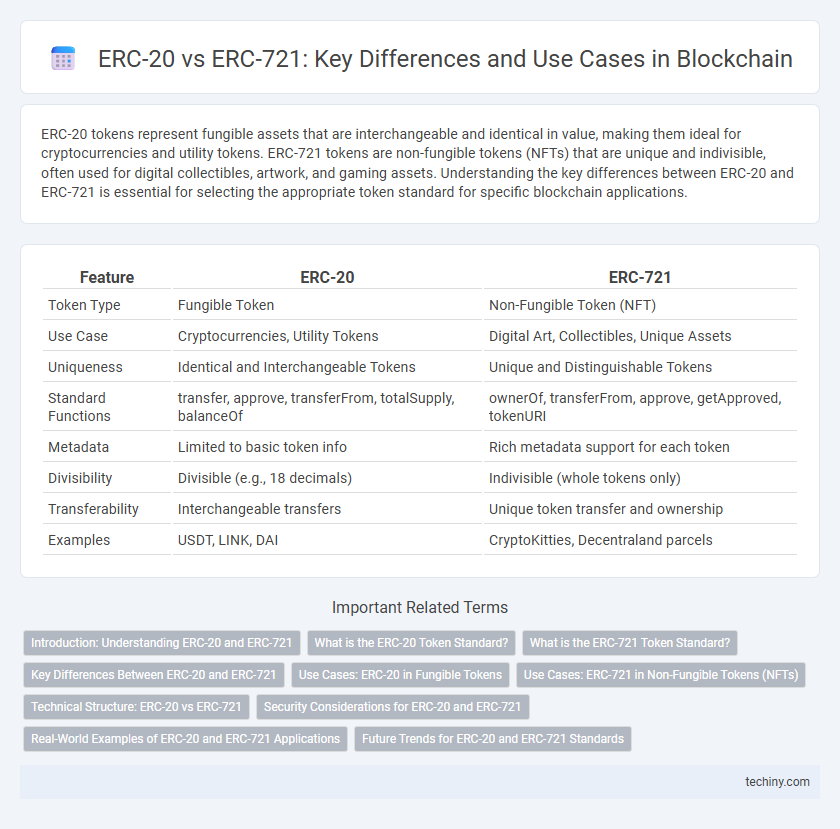ERC-20 tokens represent fungible assets that are interchangeable and identical in value, making them ideal for cryptocurrencies and utility tokens. ERC-721 tokens are non-fungible tokens (NFTs) that are unique and indivisible, often used for digital collectibles, artwork, and gaming assets. Understanding the key differences between ERC-20 and ERC-721 is essential for selecting the appropriate token standard for specific blockchain applications.
Table of Comparison
| Feature | ERC-20 | ERC-721 |
|---|---|---|
| Token Type | Fungible Token | Non-Fungible Token (NFT) |
| Use Case | Cryptocurrencies, Utility Tokens | Digital Art, Collectibles, Unique Assets |
| Uniqueness | Identical and Interchangeable Tokens | Unique and Distinguishable Tokens |
| Standard Functions | transfer, approve, transferFrom, totalSupply, balanceOf | ownerOf, transferFrom, approve, getApproved, tokenURI |
| Metadata | Limited to basic token info | Rich metadata support for each token |
| Divisibility | Divisible (e.g., 18 decimals) | Indivisible (whole tokens only) |
| Transferability | Interchangeable transfers | Unique token transfer and ownership |
| Examples | USDT, LINK, DAI | CryptoKitties, Decentraland parcels |
Introduction: Understanding ERC-20 and ERC-721
ERC-20 and ERC-721 are two foundational Ethereum token standards enabling diverse blockchain applications. ERC-20 defines a protocol for fungible tokens, allowing seamless exchangeability and standardized transactions within decentralized finance. ERC-721 introduces unique, non-fungible tokens (NFTs) that represent individual digital assets with distinct properties, revolutionizing ownership and provenance on the blockchain.
What is the ERC-20 Token Standard?
ERC-20 is a widely adopted Ethereum token standard defining a common set of rules for fungible tokens, enabling seamless interoperability across decentralized applications and smart contracts. ERC-20 tokens share uniform properties such as total supply, balance tracking, and transfer functions, making them ideal for currency-like assets and utility tokens. This standard simplifies token issuance and exchange by ensuring compatibility with wallets, exchanges, and decentralized finance (DeFi) protocols.
What is the ERC-721 Token Standard?
ERC-721 is a blockchain token standard designed for creating non-fungible tokens (NFTs) that represent unique digital assets, unlike the interchangeable ERC-20 tokens. Each ERC-721 token has distinct metadata and ownership details, enabling use cases such as digital art, collectibles, and real estate on Ethereum. The standard ensures interoperability across decentralized applications by defining a set of functions for tracking token ownership and transfer.
Key Differences Between ERC-20 and ERC-721
ERC-20 tokens represent fungible assets where each unit shares identical value and properties, enabling seamless exchange and divisibility, while ERC-721 tokens define non-fungible assets with unique identifiers and attributes, ideal for digital collectibles and ownership records. The ERC-20 standard supports batch transfers and balances tracked in simple numeric values, contrasting with ERC-721's reliance on unique token IDs and ownership mapping for distinct items. Differences in use cases and token functionality stem from these structural distinctions, influencing smart contract interactions in decentralized applications.
Use Cases: ERC-20 in Fungible Tokens
ERC-20 tokens are designed for fungibility, making them ideal for cryptocurrencies, utility tokens, and governance tokens where each unit is interchangeable. This standard supports applications in decentralized finance (DeFi) platforms, tokenized assets, and payment systems due to its uniform value and seamless transferability. ERC-20's widespread adoption ensures compatibility across wallets, exchanges, and smart contracts, optimizing liquidity and user accessibility.
Use Cases: ERC-721 in Non-Fungible Tokens (NFTs)
ERC-721 tokens are uniquely designed to represent non-fungible assets, providing distinct identifiers for each token on the Ethereum blockchain, which makes them ideal for digital art, collectibles, and gaming assets. Unlike ERC-20 tokens that are fungible and identical, ERC-721 tokens enable provenance tracking, ownership proof, and scarcity for NFTs. This specificity facilitates diverse applications such as virtual real estate, digital identity, and exclusive content access, driving innovation in decentralized marketplaces.
Technical Structure: ERC-20 vs ERC-721
ERC-20 tokens follow a standard interface with functions like transfer, approve, and balanceOf, designed for fungible assets where each token is identical in value and properties. In contrast, ERC-721 tokens implement a non-fungible token (NFT) standard with unique identifiers for each token, enabling distinct ownership, metadata, and transfer functions tailored for one-of-a-kind assets. The technical structure of ERC-721 includes methods such as ownerOf and safeTransferFrom to handle individual token provenance and secure transfers, which are absent in the ERC-20 standard focused on uniform token management.
Security Considerations for ERC-20 and ERC-721
Security considerations for ERC-20 tokens emphasize the risk of double-spending attacks and the importance of implementing proper allowance mechanisms to prevent unauthorized transfers. ERC-721 tokens, being non-fungible, require strict ownership verification and robust metadata protection to avoid token duplication and fraud. Both standards demand secure smart contract coding practices to mitigate vulnerabilities such as reentrancy and ensure transaction integrity on the Ethereum blockchain.
Real-World Examples of ERC-20 and ERC-721 Applications
ERC-20 tokens, widely used in DeFi, represent fungible assets such as stablecoins like USDT and governance tokens like Uniswap's UNI, enabling seamless trading and liquidity provision. ERC-721 tokens power non-fungible assets in gaming and digital art, exemplified by CryptoKitties and NBA Top Shot, providing verifiable ownership and scarcity. These standards underpin diverse blockchain applications by addressing distinct asset types: ERC-20 for interchangeable tokens, ERC-721 for unique, indivisible items.
Future Trends for ERC-20 and ERC-721 Standards
ERC-20 tokens continue to dominate as the standard for fungible assets and cryptocurrencies, with future trends focusing on enhanced interoperability, scalability solutions, and integration with decentralized finance (DeFi) protocols. ERC-721 standards are evolving to support more complex non-fungible token (NFT) use cases, including dynamic metadata, cross-chain compatibility, and expanded utility in gaming, digital identity, and metaverse applications. Both standards are increasingly adopting layer-2 solutions and improved security features to meet growing demands in the blockchain ecosystem.
ERC-20 vs ERC-721 Infographic

 techiny.com
techiny.com